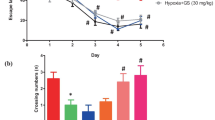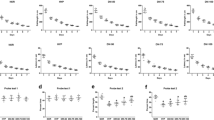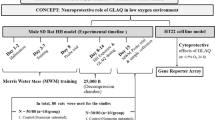Abstract
Genistein (GE) or 4′,5,7-trihydroxyflavone, a plant derived isoflavone, is a biologically active compound having several beneficial properties. Studies showed that GE possesses anti-neoplastic, anti-tumor, anti-helminthic, anti-oxidant, and anti-inflammatory activities. Herein, we investigated the neuroprotective effects of GE in a mouse model of hypoxia-induced amnesia. Mice were exposed to hypoxic conditions (10% O2) in a designated hypoxia chamber and co-treated with GE (10, 20, or 30 mg/kg) for 4 weeks. Following this, behavioral tests were performed to evaluate memory performance. We assessed microglial activation in the hippocampus, amygdala, and pre-frontal cortex (PFC) regions by evaluating the Iba-1 and GFAP transcript levels, and MIP-1β, Cox-2, and IL6 protein levels. Apoptosis was assessed by evaluating Bax, BAD, and Bcl-2 mRNA levels, and caspase-3 activity. To uncover the underlying molecular mechanism, we evaluated the levels of Nrf2, HO-1, and NQO1 in different brain regions of mice from all groups. Results showed that hypoxia-exposed mice have reduced performance in the behavioral tests and GE treatment enhanced the memory performance in hypoxia-exposed mice. Moreover, hypoxia-exposed mice showed increased expression of microglial activation markers and enhanced apoptosis in the hippocampus, amygdala, and PFC. GE treatment suppressed microglial activation and prevented apoptosis in the brain of hypoxia-exposed mice. Furthermore, hypoxia-exposure reduced the expression of Nrf2, NQO1, and HO-1 while GE treatment ameliorated this decrease in different regions of hypoxia-exposed mice brain. In conclusion, GE prevents cognitive dysfunction by suppressing microglial activation and inhibiting apoptosis in the hypoxia-exposed mice brain.






Similar content being viewed by others
Data availability
Data sharing not applicable to this article as no datasets were generated or analyzed during the current study.
References
Alam J, Cook JL (2003) Transcriptional regulation of the heme oxygenase-1 gene via the stress response element pathway. Curr Pharm Des 9(30):2499–2511. https://doi.org/10.2174/1381612033453730
Alexander GE (2004) Biology of Parkinson’s disease: pathogenesis and pathophysiology of a multisystem neurodegenerative disorder. Dialogues Clin Neurosci 6(3):259–280
Allen RJ (2018) Classic and recent advances in understanding amnesia. F1000Res 7:331. https://doi.org/10.1268/f1000research.13737.1
Arya A, Sethy NK, Singh SK, Das M, Bhargava K (2013) Cerium oxide nanoparticles protect rodent lungs from hypobaric hypoxia-induced oxidative stress and inflammation. Int J Nanomed 8:4507–4520. https://doi.org/10.2147/IJN.S53032
Bachiller S, Jimenez-Ferrer I, Paulus A, Yang Y, Swanberg M, Deierborg T, Boza-Serrano A (2018) Microglia in neurological diseases: A road map to brain-disease dependent-inflammatory response. Front Cell Neurosci 12:488. https://doi.org/10.3389/fncel.2018.00488
Baitharu I, Deep SN, Jain V, Prasad D, Ilavazhagan G (2013a) Inhibition of glucocorticoid receptors ameliorates hypobaric hypoxia induced memory impairment in rat. Behav Brain Res 240:76–86. https://doi.org/10.1016/j.bbr.2012.11.005
Baitharu I, Jain V, Deep SN, Hota KB, Hota SK, Prasad D, Ilavazhagan G (2013b) Withania somnifera root extract ameliorates hypobaric hypoxia induced memory impairment in rats. J Ethnopharmacol 145(2):431–441. https://doi.org/10.1016/j.jep.2012.10.063
Bauer J, Strauss S, Schreiter-Gasser U, Ganter U, Schlegel P, Witt I, Yolk B, Berger M (1991) Interleukin-6 and alpha-2-macroglobulin indicate an acute-phase state in Alzheimer’s disease cortices. FEBS Lett 285(1):111–114. https://doi.org/10.1016/0014-5793(91)80737-n
Beyer RE, Segura-Aguilar J, Di Bernardo S, Cavazzoni M, Fato R, Fiorentini D, Galli MC, Setti M, Landi L, Lenaz G (1996) The role of DT-diaphorase in the maintenance of the reduced antioxidant form of coenzyme Q in membrane systems. Proc Natl Acad Sci U S A 93(6):2528–2532. https://doi.org/10.1073/pnas.93.6.2528
Bolmont B, Thullier F, Abraini JH (2000) Relationships between mood states and performances in reaction time, psychomotor ability, and mental efficiency during a 31-day gradual decompression in a hypobaric chamber from sea level to 8848 m equivalent altitude. Physiol Behav 71(5):469–476. https://doi.org/10.1016/s0031-9384(00)00362-0
Braak H, Braak E, Yilmazer D, de Vos RA, Jansen EN, Bohl J, Jellinger K (1994) Amygdala pathology in Parkinson’s disease. Acta Neuropathol 88(6):493–500. https://doi.org/10.1007/BF00296485
Brettschneider J, Toledo JB, Van Deerlin VM, Elman L, McCluskey L, Lee VM, Trojanowski JQ (2012) Microglial activation correlates with disease progression and upper motor neuron clinical symptoms in amyotrophic lateral sclerosis. PLoS ONE 7(6):e39216. https://doi.org/10.1371/journal.pone.0039216
Cai Q, Wei H (1996) Effect of dietary genistein on antioxidant enzyme activities in SENCAR mice. Nutr Cancer 25(1):1–7. https://doi.org/10.1080/01635589609514423
Cho MJ, Jang SH (2021) Relationship between post-traumatic amnesia and white matter integrity in traumatic brain injury using tract-based spatial statistics. Sci Rep 11(1):6898. https://doi.org/10.1038/s41598-021-86439-0
Crisafulli A, Altavilla D, Marini H, Bitto A, Cucinotta D, Frisina N, Corrado F, D’Anna R, Squadrito G, Adamo EB, Marini R, Romeo A, Cancellieri F, Buemi M, Squadrito F (2005) Effects of the phytoestrogen genistein on cardiovascular risk factors in postmenopausal women. Menopause 12(2):186–192. https://doi.org/10.1097/00042192-200512020-00013
Di Paola M, Caltagirone C, Fadda L, Sabatini U, Serra L, Carlesimo GA (2008) Hippocampal atrophy is the critical brain change in patients with hypoxic amnesia. Hippocampus 18(7):719–728. https://doi.org/10.1002/hipo.20432
Fao L, Mota SI, Rego AC (2019) c-Src regulates Nrf2 activity through PKCdelta after oxidant stimulus. Biochim Biophys Acta Mol Cell Res 1866(4):686–698. https://doi.org/10.1016/j.bbamcr.2019.01.011
Ganai AA, Husain M (2018) Genistein alleviates neuroinflammation and restores cognitive function in rat model of hepatic encephalopathy: underlying mechanisms. Mol Neurobiol 55(2):1762–1772. https://doi.org/10.1007/s12035-017-0454-1
Gong L, Li Y, Nedeljkovic-Kurepa A, Sarkar FH (2003) Inactivation of NF-kappaB by genistein is mediated via Akt signaling pathway in breast cancer cells. Oncogene 22(30):4702–4709. https://doi.org/10.1038/sj.onc.1206583
Gossner G, Choi M, Tan L, Fogoros S, Griffith KA, Kuenker M, Liu JR (2007) Genistein-induced apoptosis and autophagocytosis in ovarian cancer cells. Gynecol Oncol 105(1):23–30. https://doi.org/10.1016/j.ygyno.2006.11.009
De Gregorio C, Marini H, Alibrandi A, Di Benedetto A, Bitto A, Adamo EB, Altavilla D, Irace C, Di Vieste G, Pancaldo D, Granese R, Atteritano M, Corrao S, Licata G, Squadrito F, Arcoraci V (2017) Genistein supplementation and cardiac function in postmenopausal women with metabolic syndrome: Results from a pilot strain-echo study. Nutrients 9(6). https://doi.org/10.3390/nu9060584
Harry GJ, Kraft AD (2012) Microglia in the developing brain: a potential target with lifetime effects. Neurotoxicology 33(2):191–206. https://doi.org/10.1016/j.neuro.2012.01.012
Horowitz JM, Pastor DM, Goyal A, Kar S, Ramdeen N, Hallas BH, Torres G (2003) BAX protein-immunoreactivity in midbrain neurons of Parkinson’s disease patients. Brain Res Bull 62(1):55–61. https://doi.org/10.1016/j.brainresbull.2003.08.005
Jahn H (2013) Memory loss in Alzheimer’s disease. Dialogues Clin Neurosci 15(4):445–454
Joelving FC, Billeskov R, Christensen JR, West M, Pakkenberg B (2006) Hippocampal neuron and glial cell numbers in Parkinson’s disease–a stereological study. Hippocampus 16(10):826–833. https://doi.org/10.1002/hipo.20212
Joers V, Tansey MG, Mulas G, Carta AR (2017) Microglial phenotypes in Parkinson’s disease and animal models of the disease. Prog Neurobiol 155:57–75. https://doi.org/10.1016/j.pneurobio.2016.04.006
Khuleshwari K, Vijay P (2021) Genistein enhances expression of extracellular regulated kinases (ERK) 1/2, and learning and memory of mouse. IBRO Neurosci Rep 10:90–95. https://doi.org/10.1016/j.ibneur.2021.01.005
Knott C, Stern G, Wilkin GP (2000) Inflammatory regulators in Parkinson’s disease: iNOS, lipocortin-1, and cyclooxygenases-1 and -2. Mol Cell Neurosci 16(6):724–739. https://doi.org/10.1006/mcne.2000.0914
Lee JY, Kim HS, Song YS (2012) Genistein as a potential anticancer agent against ovarian cancer. J Tradit Complement Med 2(2):96–104. https://doi.org/10.1016/s2225-4110(16)30082-7
Liang C, Li H, Shen C, Lai J, Shi Z, Liu B, Tao HM (2012) Genistein potentiates the anti-cancer effects of gemcitabine in human osteosarcoma via the downregulation of Akt and nuclear factor-kappaB pathway. Anticancer Agents Med Chem 12(5):554–563. https://doi.org/10.2174/187152012800617867
Liu YZ, Boxer LM, Latchman DS (1999) Activation of the Bcl-2 promoter by nerve growth factor is mediated by the p42/p44 MAPK cascade. Nucleic Acids Res 27(10):2086–2090. https://doi.org/10.1093/nar/27.10.2086
Liu LX, Chen WF, Xie JX, Wong MS (2008) Neuroprotective effects of genistein on dopaminergic neurons in the mice model of Parkinson’s disease. Neurosci Res 60(2):156–161. https://doi.org/10.1016/j.neures.2007.10.005
Lu C, Wang Y, Xu T, Li Q, Wang D, Zhang L, Fan B, Wang F, Liu X (2018) Genistein ameliorates scopolamine-induced amnesia in mice through the regulation of the cholinergic neurotransmission, antioxidant system and the ERK/CREB/BDNF signaling. Front Pharmacol 9:1153. https://doi.org/10.3389/fphar.2018.01153
Lueptow LM (2017) Novel Object Recognition Test for the Investigation of Learning and Memory in Mice. J Vis Exp(126). https://doi.org/10.3791/55718
Luo S, Lan T, Liao W, Zhao M, Yang H (2012) Genistein inhibits Abeta(2)(5)(-)(3)(5) -induced neurotoxicity in PC12 cells via PKC signaling pathway. Neurochem Res 37(12):2787–2794. https://doi.org/10.1007/s11064-012-0872-4
Lv Z, Xing K, Li G, Liu D, Guo Y (2018) Dietary genistein alleviates lipid metabolism disorder and inflammatory response in laying hens with fatty liver syndrome. Front Physiol 9:1493. https://doi.org/10.3389/fphys.2018.01493
Ma Y, Sullivan JC, Schreihofer DA (2010) Dietary genistein and equol (4’, 7 isoflavandiol) reduce oxidative stress and protect rats against focal cerebral ischemia. Am J Physiol Regul Integr Comp Physiol 299(3):R871-877. https://doi.org/10.1152/ajpregu.00031.2010
Machts J, Vielhaber S, Kollewe K, Petri S, Kaufmann J, Schoenfeld MA (2018) Global hippocampal volume reductions and local CA1 shape deformations in amyotrophic lateral sclerosis. Front Neurol 9:565. https://doi.org/10.3389/fneur.2018.00565
Maiti P, Singh SB, Ilavazhagan G (2010) Nitric oxide system is involved in hypobaric hypoxia-induced oxidative stress in rat brain. Acta Histochem 112(3):222–232. https://doi.org/10.1016/j.acthis.2008.10.005
Markovits J, Linassier C, Fosse P, Couprie J, Pierre J, Jacquemin-Sablon A, Saucier JM, Le Pecq JB, Larsen AK (1989) Inhibitory effects of the tyrosine kinase inhibitor genistein on mammalian DNA topoisomerase II. Cancer Res 49(18):5111–5117
Martinez-Romero R, Canuelo A, Siles E, Oliver FJ, Martinez-Lara E (2012) Nitric oxide modulates hypoxia-inducible factor-1 and poly(ADP-ribose) polymerase-1 cross talk in response to hypobaric hypoxia. J Appl Physiol (1985) 112(5):816–823. https://doi.org/10.1152/japplphysiol.00898.2011
Matsui T, Nagafuji T, Kumanishi T, Asano T (1999) Role of nitric oxide in pathogenesis underlying ischemic cerebral damage. Cell Mol Neurobiol 19(1):177–189. https://doi.org/10.1023/a:1006985112459
Ming GL, Song H (2011) Adult neurogenesis in the mammalian brain: significant answers and significant questions. Neuron 70(4):687–702. https://doi.org/10.1016/j.neuron.2011.05.001
Mogi M, Harada M, Kondo T, Riederer P, Inagaki H, Minami M, Nagatsu T (1994) Interleukin-1 beta, interleukin-6, epidermal growth factor and transforming growth factor-alpha are elevated in the brain from parkinsonian patients. Neurosci Lett 180(2):147–150. https://doi.org/10.1016/0304-3940(94)90508-8
Mu Y, Gage FH (2011) Adult hippocampal neurogenesis and its role in Alzheimer’s disease. Mol Neurodegener 6:85. https://doi.org/10.1186/1750-1326-6-85
Nair D, Dayyat EA, Zhang SX, Wang Y, Gozal D (2011) Intermittent hypoxia-induced cognitive deficits are mediated by NADPH oxidase activity in a murine model of sleep apnea. PLoS ONE 6(5):e19847. https://doi.org/10.1371/journal.pone.0019847
Nation DA, Bondi MW, Gayles E, Delis DC (2017) Mechanisms of memory dysfunction during high altitude hypoxia training in military aircrew. J Int Neuropsychol Soc 23(1):1–10. https://doi.org/10.1017/S1355617716000965
Offen D, Beart PM, Cheung NS, Pascoe CJ, Hochman A, Gorodin S, Melamed E, Bernard R, Bernard O (1998) Transgenic mice expressing human Bcl-2 in their neurons are resistant to 6-hydroxydopamine and 1-methyl-4-phenyl-1,2,3,6- tetrahydropyridine neurotoxicity. Proc Natl Acad Sci U S A 95(10):5789–5794. https://doi.org/10.1073/pnas.95.10.5789
Okura A, Arakawa H, Oka H, Yoshinari T, Monden Y (1988) Effect of genistein on topoisomerase activity and on the growth of [Val 12]Ha-ras-transformed NIH 3T3 cells. Biochem Biophys Res Commun 157(1):183–189. https://doi.org/10.1016/s0006-291x(88)80030-5
Ortega-de San Luis C, Ryan TJ (2018) United states of amnesia: rescuing memory loss from diverse conditions. Dis Model Mech 11(5). https://doi.org/10.1242/dmm.035055
Padurariu M, Ciobica A, Mavroudis I, Fotiou D, Baloyannis S (2012) Hippocampal neuronal loss in the CA1 and CA3 areas of Alzheimer’s disease patients. Psychiatr Danub 24(2):152–158
Park CR, Seeley RJ, Craft S, Woods SC (2000) Intracerebroventricular insulin enhances memory in a passive-avoidance task. Physiol Behav 68(4):509–514. https://doi.org/10.1016/s0031-9384(99)00220-6
Ressler KJ (2010) Amygdala activity, fear, and anxiety: modulation by stress. Biol Psychiatry 67(12):1117–1119. https://doi.org/10.1016/j.biopsych.2010.04.027
Rumman M, Pandey S, Singh B, Gupta M, Ubaid S, Mahdi AA (2021) Genistein prevents hypoxia-induced cognitive dysfunctions by ameliorating oxidative stress and inflammation in the hippocampus. Neurotox Res 39(4):1123–1133. https://doi.org/10.1007/s12640-021-00353-x
Saijo K, Winner B, Carson CT, Collier JG, Boyer L, Rosenfeld MG, Gage FH, Glass CK (2009) A Nurr1/CoREST pathway in microglia and astrocytes protects dopaminergic neurons from inflammation-induced death. Cell 137(1):47–59. https://doi.org/10.1016/j.cell.2009.01.038
Sanaei M, Kavoosi F, Valiani A, Ghobadifar MA (2018) Effect of genistein on apoptosis and proliferation of hepatocellular carcinoma Hepa1-6 cell line. Int J Prev Med 9:12. https://doi.org/10.4103/ijpvm.IJPVM_249_16
Shih AY, Johnson DA, Wong G, Kraft AD, Jiang L, Erb H, Johnson JA, Murphy TH (2003) Coordinate regulation of glutathione biosynthesis and release by Nrf2-expressing glia potently protects neurons from oxidative stress. J Neurosci 23(8):3394–3406
Siddiqui SV, Chatterjee U, Kumar D, Siddiqui A, Goyal N (2008) Neuropsychology of prefrontal cortex. Indian J Psychiatry 50(3):202–208. https://doi.org/10.4103/0019-5545.43634
Singh B, Pandey S, Rumman M, Mahdi AA (2020) Neuroprotective effects of Bacopa monnieri in Parkinson’s disease model. Metab Brain Dis 35(3):517–525. https://doi.org/10.1007/s11011-019-00526-w
Singh B, Pandey S, Rumman M, Kumar S, Kushwaha PP, Verma R, Mahdi AA (2021) Neuroprotective and neurorescue mode of action of Bacopa monnieri (L.) Wettst in 1-Methyl-4-phenyl-1,2,3,6-tetrahydropyridine-Induced Parkinson’s disease: an in silico and in vivo study. Front Pharmacol 12:616413. https://doi.org/10.3389/fphar.2021.616413
Small GW (2002) What we need to know about age related memory loss. BMJ 324(7352):1502–1505. https://doi.org/10.1136/bmj.324.7352.1502
Terraneo L, Paroni R, Bianciardi P, Giallongo T, Carelli S, Gorio A, Samaja M (2017) Brain adaptation to hypoxia and hyperoxia in mice. Redox Biol 11:12–20. https://doi.org/10.1016/j.redox.2016.10.018
Thangavel P, Puga-Olguin A, Rodriguez-Landa JF, Zepeda RC (2019) Genistein as potential therapeutic candidate for menopausal symptoms and other related diseases. Molecules 24(21). https://doi.org/10.3390/molecules24213892
Walsh DT, Perry VH, Minghetti L (2000) Cyclooxygenase-2 is highly expressed in microglial-like cells in a murine model of prion disease. Glia 29(4):392–396
Wang R, Tu J, Zhang Q, Zhang X, Zhu Y, Ma W, Cheng C, Brann DW, Yang F (2013) Genistein attenuates ischemic oxidative damage and behavioral deficits via eNOS/Nrf2/HO-1 signaling. Hippocampus 23(7):634–647. https://doi.org/10.1002/hipo.22126
Wang WY, Tan MS, Yu JT, Tan L (2015) Role of pro-inflammatory cytokines released from microglia in Alzheimer’s disease. Ann Transl Med 3(10):136. https://doi.org/10.3978/j.issn.2305-5839.2015.03.49
Wang Y, Cai B, Shao J, Wang TT, Cai RZ, Ma CJ, Han T, Du J (2016) Genistein suppresses the mitochondrial apoptotic pathway in hippocampal neurons in rats with Alzheimer’s disease. Neural Regen Res 11(7):1153–1158. https://doi.org/10.4103/1673-5374.187056
Weaver JD, Huang MH, Albert M, Harris T, Rowe JW, Seeman TE (2002) Interleukin-6 and risk of cognitive decline: MacArthur studies of successful aging. Neurology 59(3):371–378. https://doi.org/10.1212/wnl.59.3.371
Wu Y, Dissing-Olesen L, MacVicar BA, Stevens B (2015) Microglia: dynamic mediators of synapse development and plasticity. Trends Immunol 36(10):605–613. https://doi.org/10.1016/j.it.2015.08.008
Yang SY, Pyo MC, Nam MH, Lee KW (2019) ERK/Nrf2 pathway activation by caffeic acid in HepG2 cells alleviates its hepatocellular damage caused by t-butylhydroperoxide-induced oxidative stress. BMC Complement Altern Med 19(1):139. https://doi.org/10.1186/s12906-019-2551-3
Yovell Y, Bannett Y, Shalev AY (2003) Amnesia for traumatic events among recent survivors: a pilot study. CNS Spectr 8(9):676–680, 683–675. https://doi.org/10.1017/s1092852900008865
Zhai X, Lin M, Zhang F, Hu Y, Xu X, Li Y, Liu K, Ma X, Tian X, Yao J (2013) Dietary flavonoid genistein induces Nrf2 and phase II detoxification gene expression via ERKs and PKC pathways and protects against oxidative stress in Caco-2 cells. Mol Nutr Food Res 57(2):249–259. https://doi.org/10.1002/mnfr.201200536
Zhang T, Wang F, Xu HX, Yi L, Qin Y, Chang H, Mi MT, Zhang QY (2013a) Activation of nuclear factor erythroid 2-related factor 2 and PPARgamma plays a role in the genistein-mediated attenuation of oxidative stress-induced endothelial cell injury. Br J Nutr 109(2):223–235. https://doi.org/10.1017/S0007114512001110
Zhang Z, Wang CZ, Du GJ, Qi LW, Calway T, He TC, Du W, Yuan CS (2013b) Genistein induces G2/M cell cycle arrest and apoptosis via ATM/p53-dependent pathway in human colon cancer cells. Int J Oncol 43(1):289–296. https://doi.org/10.3892/ijo.2013.1946
Zhang L, Qian Y, Li J, Zhou X, Xu H, Yan J, Xiang J, Yuan X, Sun B, Sisodia SS, Jiang YH, Cao X, Jing N, Lin A (2021) BAD-mediated neuronal apoptosis and neuroinflammation contribute to Alzheimer’s disease pathology. iScience 24(9):102942. https://doi.org/10.1016/j.isci.2021.102942
Zhao Y, Zhu Y, Wang P, Sang S (2020) Dietary genistein reduces methylglyoxal and advanced glycation end product accumulation in obese mice treated with high-fat diet. J Agric Food Chem 68(28):7416–7424. https://doi.org/10.1021/acs.jafc.0c03286
Zhou P, Wang C, Hu Z, Chen W, Qi W, Li A (2017) Genistein induces apoptosis of colon cancer cells by reversal of epithelial-to-mesenchymal via a Notch1/NF-kappaB/slug/E-cadherin pathway. BMC Cancer 17(1):813. https://doi.org/10.1186/s12885-017-3829-9
Zhou L, Xiao X, Zhang Q, Zheng J, Li M, Yu M, Wang X, Deng M, Zhai X, Li R, Liu J (2019) Dietary genistein could modulate hypothalamic circadian entrainment, reduce body weight, and improve glucose and lipid metabolism in female mice. Int J Endocrinol 2019:2163838. https://doi.org/10.1155/2019/2163838
Zhou S, Zhong Z, Huang P, Xiang B, Li X, Dong H, Zhang G, Wu Y, Li P (2021) IL-6/STAT3 induced neuron apoptosis in hypoxia by downregulating ATF6 expression. Front Physiol 12:729925. https://doi.org/10.3389/fphys.2021.729925
Zhu M, Allard JS, Zhang Y, Perez E, Spangler EL, Becker KG, Rapp PR (2014) Age-related brain expression and regulation of the chemokine CCL4/MIP-1beta in APP/PS1 double-transgenic mice. J Neuropathol Exp Neurol 73(4):362–374. https://doi.org/10.1097/NEN.0000000000000060
Zirlinger M, Kreiman G, Anderson DJ (2001) Amygdala-enriched genes identified by microarray technology are restricted to specific amygdaloid subnuclei. Proc Natl Acad Sci U S A 98(9):5270–5275. https://doi.org/10.1073/pnas.091094698
Funding
This study was supported by the Grain-in-Aid from Science and Engineering Research Board (SERB), India (Grant No: EMR/2017/000282).
Author information
Authors and Affiliations
Contributions
MR and SP designed the study. MR performed the experiments, analyzed the data, and wrote the manuscript. MG helped in animal studies. BS, SP, AAM helped in revising the manuscript. All authors have read and approved the manuscript for submission.
Corresponding author
Ethics declarations
Ethical approval
This study was approved the Ethical Committee for Animal Experimentation of the King George’s Medical University (KGMU), Lucknow (145/IAEC/2021).
Competing interests
The authors declare that they have no competing financial interests.
Additional information
Publisher's note
Springer Nature remains neutral with regard to jurisdictional claims in published maps and institutional affiliations.
Rights and permissions
About this article
Cite this article
Rumman, M., Pandey, S., Singh, B. et al. Genistein suppresses microglial activation and inhibits apoptosis in different brain regions of hypoxia-exposed mice model of amnesia. Metab Brain Dis 37, 2521–2532 (2022). https://doi.org/10.1007/s11011-022-01039-9
Received:
Accepted:
Published:
Issue Date:
DOI: https://doi.org/10.1007/s11011-022-01039-9




